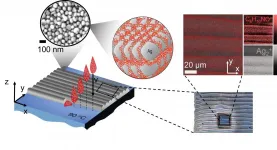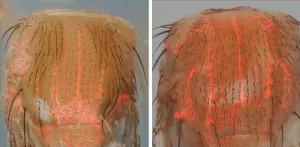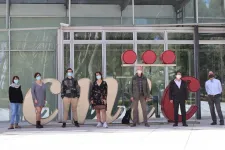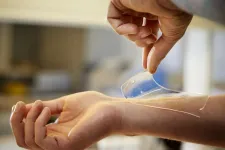(Press-News.org) Inks containing metal nanoparticles are among the most commonly-used conductive materials for printed electronics. Ink-jetting layers of MNP materials allows for unpreceded design flexibility, rapid processing and 3D printing of functional electronic devices such as sensors, solar panels, LED displays, transistors and smart textiles.
Inkjet 3D printing of metals typically form a solid printed object via a two-step process: solvent evaporation upon printing (pinning) and subsequent low-temperature consolidation of nanoparticles (sintering). The low temperature is important as in many applications the nanoparticles are co-printed with other functional/structural organic materials that are sensitive to higher temperatures.
However, layers produced by inkjet printing of metal nanoparticles have different electrical conductivity between horizontal and vertical directions. This effect is known as functional anisotropy and is a long-standing problem for the 3D printing of functional electronic devices, preventing its use for advanced applications.
It was previously thought that reduced vertical conductivity through a printed device is mainly caused by shape and physical continuity problems at the interfaces of the constituent nanoparticles (at the very small micro and nanoscale). However, Nottingham researchers used silver nanoparticles to show, for the first time, that it is caused by organic chemical residues in the inks.
These residues, which are added to the inks to help stabilise the nanomaterials, lead to the formation of low-conducting, very thin nanoscale layers which interfere with the electrical conductivity of the printed sample in the vertical direction.
With a clearer understanding of the distribution of residual organic additives within printed layers, the researchers hope to go on to define new techniques and develop new ink formulations to overcome functional anisotropy of inkjet-based 3D printed electronics.
Lead author, CfAM Research Fellow Dr Gustavo Trindade, said, "The conductivity of inkjet-printed metal nanoparticles is known to be dependent on processing temperature and have been previously attributed to changes in the shape and porosity of clustered nanoparticles, with the role of organic residues being only speculated."
"This new insight enables the development of routes to overcome functional anisotropy in inkjet-based nanoparticles, and will therefore improve uptake of this potentially transformational technology, making it competitive with conventional manufacturing. Our approach is transferable to other nanomaterial-based inks including those containing graphene and functionalised nanocrystals, and will enable the development and exploitation of both 2D and 3D printed electronics like flexible and wearable sensors, solar panels, LED displays, transistors and smart textiles."
The study was carried out by the Centre for Additive Manufacturing (CfAM), under the £5.85m EPSRC-funded Programme Grant, Enabling Next Generation Additive Manufacturing. Their findings are published in a new paper 'Residual polymer stabiliser causes anisotropic electrical conductivity during inkjet printing of metal nanoparticles' in the Nature journal Communications Materials.
The researchers used the unique chemical sensitivity of a state-of-the-art 3D orbiSIMS instrument owned by the University of Nottingham. The Nottingham orbiSIMS - the only one at a UK university - allows label-free 3D chemical imaging of materials with very high resolution, revealing insights that have informed this study.
INFORMATION:
For a copy of the paper and media interviews contact Dr Gustavo Trindade on G.FerrazTrindade@nottingham.ac.uk, or Emma Lowry Media Relations Manager (Engineering) on 0115 846 7156 or emma.lowry@nottingham.ac.uk
The University of Nottingham
The University of Nottingham is a research-intensive university with a proud heritage, consistently ranked among the world's top 100. Studying at the University of Nottingham is a life-changing experience and we pride ourselves on unlocking the potential of our students. We have a pioneering spirit, expressed in the vision of our founder Sir Jesse Boot, which has seen us lead the way in establishing campuses in China and Malaysia - part of a globally connected network of education, research and industrial engagement. We are ranked eighth for research power in the UK according to REF 2014. We have six beacons of research excellence helping to transform lives and change the world; we are also a major employer and industry partner - locally and globally. Alongside Nottingham Trent University, we lead the Universities for Nottingham initiative, a pioneering collaboration which brings together the combined strength and civic missions of Nottingham's two world-class universities and is working with local communities and partners to aid recovery and renewal following the COVID-19 pandemic.
CfAM
Additive manufacturing (AM) technologies, also known as 3D printing, continue to evolve rapidly into crucial 21st Century manufacturing practises. At the University of Nottingham, the Centre for Additive Manufacturing (CfAM) is at the forefront of this development. To address the exciting engineering research challenges arising from this, CfAM combines several innovative strands of engineering research to span fundamental and translational research. Implemented as an interlinked and progressive programme of research projects, our activities include the investigation of the underpinning material deposition process, the formulation and selection of entirely new materials, the exploration of new computation-based design philosophies and novel deployment approaches for a wide range of industrial sectors. Whilst always keeping a keen eye on industrial implementation the vision guiding CfAM has always had its focus ahead of the current state of the art of AM technological capability.
EPSRC Programme Grant: Enabling Next Generation Additive Manufacturing
This EPSRC Programme Grant has the ambitious goal of developing next generation AM for the in situ production of multi-functional devices.
We aim to control the co-deposition of functional and structural materials to generate whole systems, as opposed to single material component parts. Delivering this goal challenges us to establish compatibility at the interfaces where differences in the physical and chemical properties of various materials meet. The Programme's multi-institution (Universities of Nottingham, Warwick and Birmingham) and multidisciplinary team is using state of the art equipment and approaches to analyse such interfaces, thereby accurately modelling and simulating multi-material AM - from constituent materials to multifunctional components - and developing novel materials to manufacture working electronic and bio/pharmaceutical devices.
Researchers at the University of California San Diego have laid the groundwork for a potential new type of gene therapy using novel CRISPR-based techniques.
Working in fruit flies and human cells, research led by UC San Diego Postdoctoral Scholar Zhiqian Li in Division of Biological Sciences Professor Ethan Bier's laboratory demonstrates that new DNA repair mechanisms could be designed to address the effects of debilitating diseases and damaged cell conditions.
The scientists developed a novel genetic sensor called a "CopyCatcher," which capitalizes on CRISPR-based gene drive technology, to detect instances in which a genetic element is copied precisely from one chromosome to another throughout cells in ...
Researchers at the University of Bristol have discovered how microbes responsible for human African sleeping sickness produce sex cells.
In these single-celled parasites, known as trypanosomes, each reproductive cell splits off in turn from the parental germline cell, which is responsible for passing on genes. Conventional germline cells divide twice to produce all four sex cells - or gametes - simultaneously. In humans four sperms are produced from a single germline cell. So, these strange parasite cells are doing their own thing rather than sticking to ...
Every high-school physics student learns that sound and light travel at very different speeds. If the brain did not account for this difference, it would be much harder for us to tell where sounds came from, and how they are related to what we see.
Instead, the brain allows us to make better sense of our world by playing tricks, so that a visual and a sound created at the same time are perceived as synchronous, even though they reach the brain and are processed by neural circuits at different speeds.
One of the brain's tricks is temporal recalibration: ...
A novel technique for studying vortices in quantum fluids has been developed by Lancaster physicists.
Andrew Guthrie, Sergey Kafanov, Theo Noble, Yuri Pashkin, George Pickett and Viktor Tsepelin, in collaboration with scientists from Moscow State University, used tiny mechanical resonators to detect individual quantum vortices in superfluid helium.
Their work is published in the current volume of Nature Communications.
This research into quantum turbulence is simpler than turbulence in the real world, which is observed in everyday phenomena such as surf, fast flowing rivers, billowing storm clouds, or chimney smoke. Despite ...
Scientists at the Centro Nacional de Investigaciones Cardiovasculares Centro de Biología Molecular Severo Ochoa (CBM-CSIC-UAM) have discovered that the nitric oxide (NO) pathway is overactivated in the aortas of mice and patients with Marfan Syndrome and that the activity of this pathway causes the aortic aneurysms that characterize this disease.
The results of the study, published today in Nature Communications, reveal the essential role played by NO in Marfan Syndrome aortic disease and identify new therapeutic targets and markers of NO pathway activation that could be used to monitor disease status and progression.
Aortic aneurysm ...
A new paper in the Journal of the European Economic Association, published by Oxford University Press, indicates that distrust generated by a 2011 CIA-led vaccination campaign ruse designed to catch Osama Bin Laden resulted in a significant vaccination rate decline in Pakistan.
Using a local doctor, the US Central Intelligence Organization planned an immunization plan in Pakistan to obtain DNA samples of children living in a compound in Abbottabad where American authorities suspected Bin Laden was hiding in order to obtain proof of Bin Laden's location (because the presence of close ...
About 42% of rural school districts in the U.S. offered fully in-person instruction as of February, compared with only 17% for urban districts, according to a new RAND Corporation survey of school district leaders. The opposite pattern held for fully remote learning: 29% of urban districts offered fully remote instruction compared with 10% of rural districts and 18% of suburban districts.
The choice of in-person versus remote learning has important implications. Over a third of all U.S. school districts offering some form of remote instruction in early 2021 had shortened the school day, and a quarter had reduced instructional minutes.
"This survey shows how the choice of remote instruction has ramifications that extend beyond longstanding concerns about ...
Aqueducts are very impressive examples of the art of construction in the Roman Empire. Even today, they still provide us with new insights into aesthetic, practical, and technical aspects of construction and use. Scientists at Johannes Gutenberg University Mainz (JGU) investigated the longest aqueduct of the time, the 426-kilometer-long Aqueduct of Valens supplying Constantinople, and revealed new insights into how this structure was maintained back in time. It appears that the channels had been cleaned of carbonate deposits just a few decades before the ...
Researchers at Chalmers University of Technology, Sweden, have developed a new material that prevents infections in wounds - a specially designed hydrogel, that works against all types of bacteria, including antibiotic-resistant ones. The new material offers great hope for combating a growing global problem.
The World Health Organization describes antibiotic-resistant bacteria as one of the greatest threats to global health. To deal with the problem, there needs to be a shift in the way we use antibiotics, and new, sustainable medical technologies must be developed.
"After testing our new hydrogel on different types of bacteria, we observed a high level of effectiveness, including against those ...
In some countries of the WHO European Region, 1 in 3 children aged 6 to 9 years is living with overweight or obesity. Mediterranean countries have the highest rates of obesity, but the situation there is starting to improve.
These are some of the findings of a new WHO European Childhood Obesity Surveillance Initiative (COSI) report on the fourth round of data collection (2015-2017), presented at this week's European Congress on Obesity (held online this year). The report gives the latest data available on 6- to 9-year-olds in 36 countries in the region. A questionnaire collecting ...






